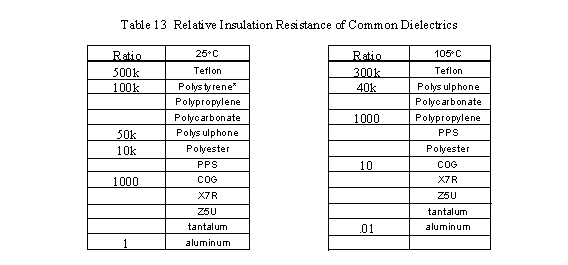
"Ratio" gives a very rough idea of the difference between one dielectric and another, all thing being equal. Insulation resistance (IR) can vary considerably from part to part. The electrolytics and class 2-4 ceramics should be used with care when leakage is important. Either use film capacitors or make very sure the guaranteed leakage is low enough. Actual numbers are not shown because they will vary with voltage ratings (and test method). In fact, in some applications a 50 V polyester, a 100 V C0G, and a 1000 V Z5U might all work equally well, assuming their other properties are satisfactory.
Many manufacturer IR charts go from 25C to perhaps 125C (depending on the dielectric of interest). These charts give the impression that IR always decreases as temperature increases. As one goes below 25C, this may not be the case. Common film dielectrics generally have maximum insulation resistance between 0C and 25C. According to some manufacturor´s charts, leakage at -50C may be as high as at +50C. Ceramic IR curves don´t show this sort of reversal, but they do tend to flatten out below25C. Someday I might test this myself.



